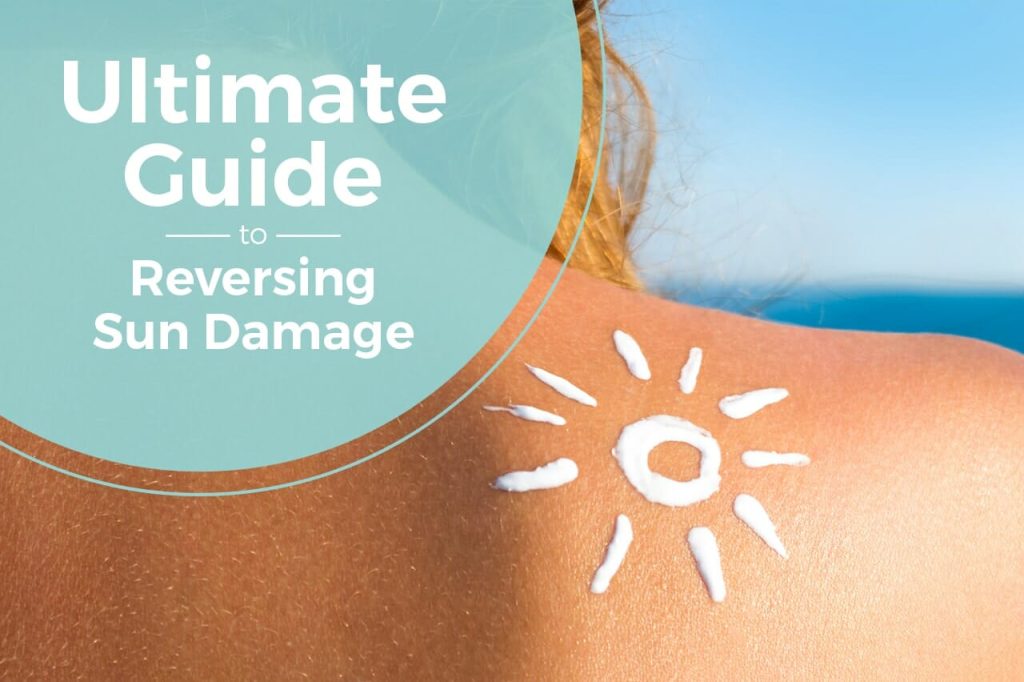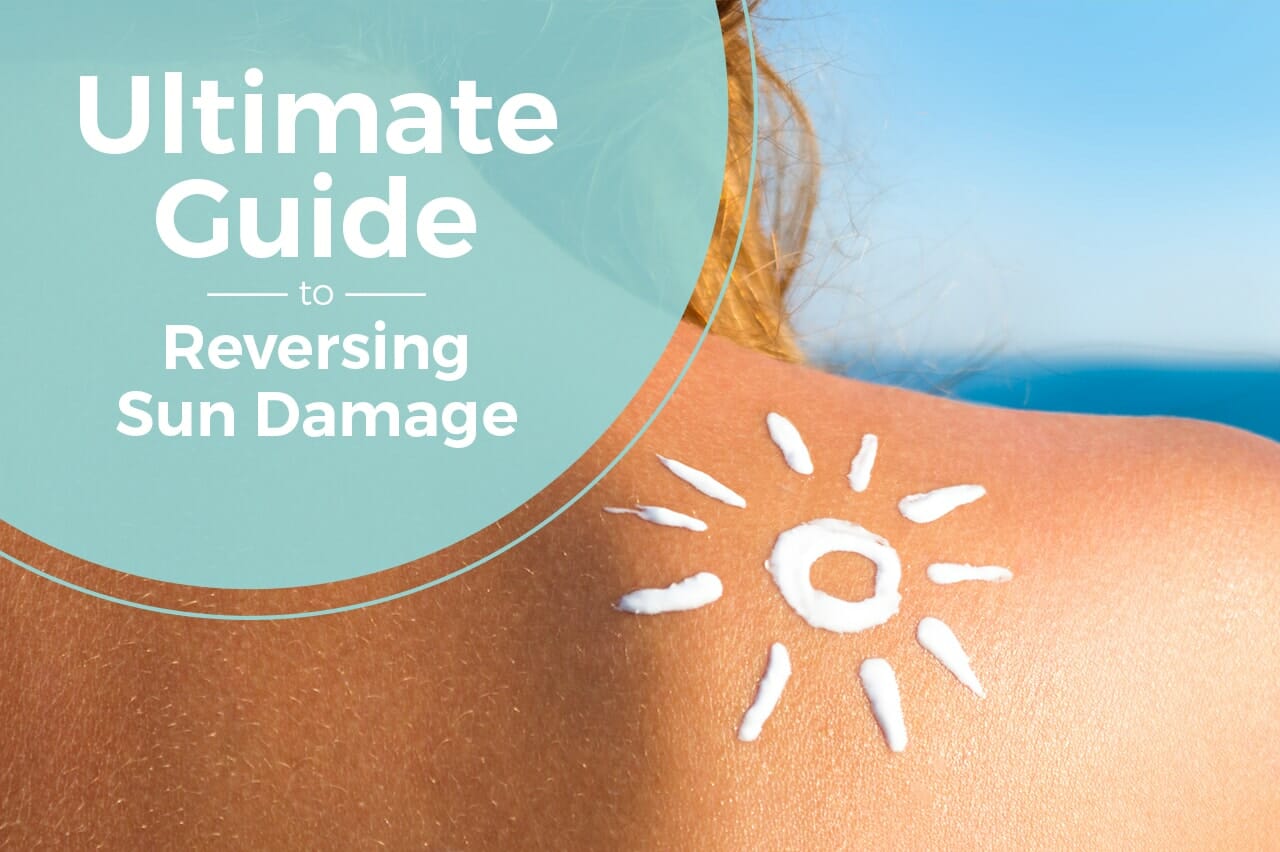
The Ultimate Guide to Reversing Sun Damage
Everyone looks better with a healthy glow, which is why it’s a good idea to get out in the sun when you can. In addition, your skin absorbs Vitamin D from sunlight, improving your mood. There’s nothing better than being outside on a warm, sunny day.
Unfortunately, the sun can also damage your skin, and with extended and repeated exposure, your healthy glow turns into brown spots and wrinkles. Learning to protect your skin from the damaging effects of sunshine while enjoying the healthy benefits is important. If it’s too late to prevent, this guide will show you how to get rid of sun damage on your skin.
How Sun Damage Occurs
Exposure to the sun has several effects on skin. It can add a light, tan tone that makes you look healthy. You may also get a dark brown, sometimes leathery look. And, of course, your skin could burn to a bright red, painful hue.
Even though that light tan looks healthy, it represents a certain amount of skin damage. The outer layer of skin is where the color is. When those skin cells are exposed to the UV rays in sunlight, a reaction takes place that causes the cells to release more melanin, skin color. Additional melanin release indicates damage in the DNA of your skin cells.
The natural melanin in your skin protects it from sustaining deeper damage from sun exposure. This is why getting a base tan before prolonged exposure to the sun may keep you from burning. Also, people with a naturally darker skin tone tend to have a higher tolerance to sun exposure without burning.
With enough exposure to the sun, your skin will turn red, no matter how much melanin your skin contains. A sunburn is an indication that your body’s inflammatory response has been triggered to protect against a dangerous invasion. The blood vessels just under the surface of the skin dilate, creating the red hue.
The next step in a sunburn is usually a tight feeling in your skin. This is a result of dehydration. Dilated blood vessels allow your skin to lose moisture quickly. By remaining in the sun, you accelerate this process further. The subsequent peeling of your skin results from the death of cells in the outer layer of skin. Your body goes through this process to keep the UV rays from damaging the DNA in the deeper layers of your skin.
Why It’s Important to Avoid Sun Damage
A sunburn may be an uncomfortable part of your summer vacation, but it typically only lasts a couple days. However, the damage to your skin from the sun lasts much longer than the sunburn. Since the UV rays alter the DNA in your skin cells beneath the surface, the damage can remain below the surface until next summer’s burn. Then, the damage is compounded until it results in discoloration, bumps, rashes or tumors.
Sun damage can be cumulative and have lasting effects that go deeper than appearance. The damaging UV rays can cause:
- Benign tumors
- A yellow discoloration
- Pre-cancerous patches
- Destruction of collagen tissue
- Brown spots
- Cancerous lesions
- Mottled pigmentation
- Telangiectasias (spider veins)
Sun exposure can cause abnormal cells to develop and multiply rapidly. The group of abnormal cells can be cancerous. Skin cancer is the most prevalent type of cancer in America, but it can be treated if it’s detected early. If left untreated, it can be the deadliest form of cancer as it grows quickly and spreads easily to other organs.
Cancer is the most serious side effect of sun damage, but it’s not the only one. Unattractive brown patches or a yellow discoloration of the skin can occur. The sun dehydrates your skin and can cause it to age prematurely. UV rays break down the collagen that gives your skin its elastic quality. When your skin no longer stretches easily, it wrinkles instead.
Signs of Sun Damage
It does not have to be extremely hot outside for you to sustain sun damage. Sitting in the shade or experiencing sunshine filtered through clouds does not prevent sun damage. You can even get a sunburn in the winter if you are outside in the sun long enough.
A sunburn is the most noticeable sign of sun damage. A tan also indicates skin damage from the sun. Blotchy skin tone and brown spots are other signs that your skin is damaged from sun exposure. Wrinkles can also reveal sun damage. These signs can develop over time or cumulative sun exposure. When your sunburn goes away, the damage to your skin is still there, under the surface.
Here are some signs of sun damage you might not be aware of:
- Scaly rough patches of skin or raised bumps. These spots, called keratoses, can come and go. They may itch or change colors to match your skin tone. Between 10 and 15% of these will turn into skin cancer, so your doctor will want to monitor them closely or even remove them.
- Brown spots that look like giant freckles. Some people refer to these as age spots or liver spots. They are more visible with age and can get darker over time. These age spots are more detrimental when they develop an uneven texture, irregular border or color variations within one spot.
- Moles that suddenly change. A mole is not uncommon, but when you have one that changes size, color or texture, it could be a sign of sun damage on your skin.
- A brownish-red coloration of skin. The skin on your neck and cheeks may itch or burn and turn change colors, a symptom called poikiloderma of civatte. This is another sign of sun damage.
- Red patches on the skin. Sun exposure can cause tiny blood vessels in the skin to burst and give skin a red hue called rosacea. Not all rosacea is caused by sun damage, but it is possible to develop the condition with extended sun exposure.
- Crow’s feet and laugh lines. Those wrinkles you attribute to age could be signs of sun damage on your skin. Exposure to UV rays breaks down the collagen in your skin making it slower to bounce back when it’s folded by the muscles underneath. After you smile, those little creases at the corners of your eyes don’t smooth out when you relax your facial muscles.
Some of these signs of skin damage can be serious. If you suspect you have sun damage, it’s a good idea to consult a doctor. Skin cancer, when it develops, spreads quickly. You want to be sure your doctor is monitoring any potentially cancerous conditions on your skin.
Vulnerability to Skin Damage From the Sun
Melanin in your skin provides some protection against the harmful rays of the sun. People with darker skin tones can tolerate more sun exposure without sustaining damage. It’s always a good idea to protect your skin with sunscreen, though. People who don’t burn easily may not be aware of the damage their skin is facing from sun exposure.
People with freckles are more vulnerable to sun damage than others. Freckles tend to pop up on light-toned skin in people with blonde or red hair. These complexions are more susceptible to sun damage than others.
Other people who may be at greater risk for skin damage from the sun are people who work outside. They get used to the heat, and their skin may become tanned and never burn, but the damage is occurring at the cellular level. People who live at high altitudes or near the equator, where the sun is stronger, are also more likely to get skin damage.
Sunscreen is a good way to protect your skin from damaging UV rays, but it doesn’t make you invincible against the sun. Suntan lotion will increase the amount of time you can safely be outside in the sun and should be worn whenever you go outside.
Some things that won’t protect you from sun damage include fabric and glass. You can get a sunburn driving down the highway on a sunny day with your windows closed. Putting a shirt on to protect your shoulders when you’re at the beach only has limited value. The UV rays will penetrate the fabric and cause skin damage over time.
Working or playing around the water makes you especially vulnerable to sun damage. The rays of the sun reflect off the water and attack you from two directions. Meanwhile, being in the water keeps you cool, so you don’t realize you’re burning.
It’s important to understand your risks when going outside into the sun and protect your skin appropriately. Everyone is susceptible to sun damage, so always take precautions. On especially hot days, try to limit your sun exposure, taking frequent breaks from work or play to go inside. When you can, schedule outdoor activities at the beginning or end of the day when the sun’s rays are less intense.
How to Fade Brown Spots From Sun Damage
It’s almost impossible to avoid any sun exposure during your lifetime. Even if you’re very careful about protecting your skin now, you may have over-exposed it when you were younger. The signs of that damage could just become visible now.
One of the most common signs of sun damage is brown spots on your skin. At first, they may just look like freckles, but as you get older they grow. Those brown spots can also be associated with age and give your skin a dull appearance.
For fading those brown spots from sun damage, the first step is to be sure they do not get worse. Protect your skin with sunscreen whenever you go outside. It’s a good idea to use a moisturizer with sunscreen every day. Even in the winter, you don’t realize how much sun exposure you get. When you plan to be outside for a long period of time, layer on a stronger sunscreen.
You can use a topical product called skin bleach to fade the brown spots — it doesn’t contain any bleaching agents. Instead, the cream slows your skin’s production of melatonin, the substance responsible for skin color. You can apply this cream to the brown spots regularly until they fade.
One trick to making the skin bleach work better is to exfoliate your skin first. By removing the dead skin cells on the surface of your skin, you allow the cream to get to the melatonin-producing cells easier. Exfoliating should reduce the look of brown spots slightly, too.
How to Reverse Sun Damage on Neck and Chest
Neck and chest skin damage from the sun can make you look older than you really are. It causes the skin to wrinkle, freckle and appear thin. The UV rays attack the elastic materials in skin and promote dehydration. Sun exposure is essentially advanced aging for your skin.
There are a couple strategies you can use for reversing sun damage on your neck and chest:
- Sloughing off the dead skin cells from the surface of your skin will encourage newer cells to work their way to the surface. You may notice the uneven skin tone on your neck and chest lessened after using an exfoliant. There are abrasive exfoliants, but a more delicate touch is recommended for your neck and chest. Try an alpha-hydroxy or beta-hydroxy product. These will remove dead skin cells and promote the production of new skin cells.
- This solution can work from the inside. Increasing your intake of Vitamin C and other antioxidants will improve the health of your skin. They stop free-radicals from damaging your collagen production and slow the signs of skin damage that tend to develop over time. Good sources of antioxidants are fresh fruits and vegetables. Try adding blueberries, eggplant, spinach and broccoli to your diet. You can also use a topical antioxidant to apply the healing directly to your neck and chest skin.
- You may think it’s too late for sunscreen, but it can help reduce the signs of sun damage on your neck and chest. Use a strong sunscreen with at least SPF 50. Apply it to your neck and chest every day. Blocking out any potential new sun damage will give your skin a chance to heal itself. Depending on how serious the damage is, you should see improvement over time.
It’s very important to protect your skin from the damaging effects of the sun, especially while you’re treating it for sun damage. Exfoliants and even antioxidants will make your skin more vulnerable to the sun. By removing the outer layer of skin cells, they take away some of your natural protection. As your skin heals itself, it will be better able to protect you. But while you’re treating sun damage, be especially careful to use sunscreen.
Professional Skin Treatments
The key to reversing skin damage due to the sun is to remove the affected skin cells and allow fresh, undamaged cells to grow while protecting the skin from further damage. The methods mentioned above can be done at home and will show some results after several applications.
To reverse more severe signs of skin damage, your dermatologist has a few other options for you. Having your sun-damaged skin professionally treated can improve the results and speed up the process. Professional treatments for sun damaged skin include:
- Chemical peels. This option is a bit like the exfoliation treatments you do at home, but more thorough. Chemical peels are designed to peel away the top layer of skin to reveal younger looking skin. They take with them a lot of the surface imperfections created by long-time exposure to the sun. Different types of chemical peels reach skin cells at different depths. Following a chemical peel, you may experience some downtime when your face is slightly swollen and red.
- A more abrasive means of removing cells from the surface of the skin, dermabrasion uses a small electrical machine. It can be used to take off rough patches and other raised areas of damaged skin. After a dermabrasion treatment, new skin cells grow in and look smoother and healthier. Another form of dermabrasion called microdermabrasion can be used for smaller areas.
- To plump up your skin and reduce wrinkles caused by sun damage, various types of fillers can be used. Tiny amounts of fillers are injected under the skin to make the skin look smoother and fill out wrinkles. These procedures can be repeated frequently and the results last up to several months.
A dermatologist would be able to assess the amount and type of your skin damage and make an appropriate recommendation for the most effective treatment. There are also some prescription strength topical creams available that might be helpful. A dermatologist will design a treatment plan and follow up on the results. You can also count on your dermatologist for preventative measures to help you avoid future skin damage from the sun.
Laser Treatment for Sun-Damaged Skin
Laser resurfacing is a traditional treatment for many of the signs of sun damage on the skin. It’s very similar to other exfoliant techniques, only it uses a laser. The laser removes the damaged skin cells instantly and encourages new cells to grow in their place.
Typical laser treatments for reversing skin damage are rather aggressive and require an average of one week of down time for the skin to heal. During that time, the treated skin needs to be protected and heavily moisturized. One advantage to laser resurfacing is that it can reach damaged skin cells that are quite deep. When your skin heals, the surface skin will be mostly new.
Another form of treatment for skin damage though, Lumecca, uses a different type of laser. Intense Pulse Light therapy (IPL) uses a red, low-level laser on sun-damaged skin. Photons from the laser are transmitted about three inches into the skin to stimulate the growth of healthy skin cells.
The benefits of using Lumecca for reversing sun damage include:
- Increased healing response in skin
- Reduced inflammation
- Improved immune response to protect skin in the future
- Better lymph drainage
- Increased collagen production
- Eliminated need for pain medication
Lumecca IPL doesn’t require the downtime of other laser treatments or chemical peels. It doesn’t destroy skin cells on the surface, but rather goes directly beneath the top layer of skin to where the real damage is. Lumecca is a non-ablative treatment, which means it doesn’t remove that top layer to get to the damaged cells underneath.
Lumecca IPL therapy can be used to treat multiple skin conditions, including:
- Rosacea
- Spider veins
- Brown spots
- Acne
- Pigment variations
- Sun damage
The results from Lumecca can be seen in one to three treatments. The treatments are painless and allow you to return to work or other activities immediately following.
Learn More
The best way to manage skin damage from sun exposure is to avoid it in the first place. Take every precaution to protect your skin from the damaging rays of the sun. Many of the signs of skin damage can be reversed with the right treatments.
To learn more about reversing skin damage from the sun, contact Synergy Wellness Center to book a consultation appointment. We offer Lumecca and other effective skin treatments to help you look and feel your best.



